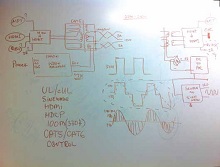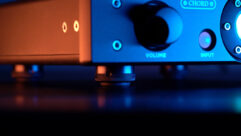

When Altinex describes their Muse product as ACBaseT, it’s a catchy way of saying AC display power (with HDMI) over CAT6. It’s 120V AC voltage for a display located many feet away from a power source. Obviously I don’t need to tell you the significance of being able to remote the power from the display, or send display power and HDMI (plus RS-232 and IR control) over a single category cable. The innovation is simple; the application ranges from convenient to transformative, depending on your install.
But simple is not always easy. So this is a bit of an engineering adventure story, and also an explanation of how the Muse got its name.
I remember when Altinex announced the concept three Info- Comms ago. I took my CEO to the booth because he had been talking about putting a TV by his pool. But meanwhile back in engineering, the product was stubbornly refusing to come together. Every engineer knows that moment—the thing that “should” work but just won’t. The innovation Altinex had just announced, the idea that had packed their booth, had a seemingly fatal flaw. But what was it and how to fix it? The answer will seem simple, as answers often are. But it’s only simple looking back.
Altinex Founder/CEO Jack Gershfeld says the story started at a brainstorming session with Grant Cossey, VP of sales. HDBaseT was becoming popular and they were asking themselves what kind of product would solve an immediate need in the industry.
“The funny thing was we had a monitor connected and we didn’t have the monitor extension cord; we had CAT 6 running to the monitor with the video. We both had the same thought at the same time, ‘what if we could send the AC power to the monitor on the same CAT 6 cable? What if an installer didn’t need AC power out?’ We estimated six months to get the product to market. The imagination is great, the reality is quite different. We were running into problem after problem. We were having transmission problems and video problems and it became clear there was a reason why people didn’t do it before. It was so discouraging.
“At that time I was traveling to Oregon on a plane, watching a TED Talk at 32,000 feet. The author of Eat Pray Love was talking about how when she’s stuck, she calls down her muse. ‘I’m here,’ she says, ‘I’m ready to solve the problem, I’m doing everything I can think of. Can you just show up?’ ”
Gershfeld had nothing to lose, so he tried it. He asked for the muse, and put pencil to napkin (pictured) one more time.
“As soon as I landed in Portland, I called back to engineering and said, ‘Serge—I want you to try this.’ Thirty minutes later he calls back to say it works.”

03The Muse team: Viktoria, Grant,Steve, Tim, Serge, Chris, Leni, Jim,Cesar, Alex, Jack
The answer was in how they managed the startup sequence for the monitor power. “We had underestimated how much management it would take to power up the monitor.” Gershfeld says. That’s because the capacitors need to charge, otherwise the monitor looks like a short circuit when it’s first plugged it in. Getting the required 20 amps of AC wasn’t hard—that was just a cheap invertor. But across the CAT 6 cable, the voltage drop kept shutting down the system.
The inspiration, Gershfeld says, was realizing that to meet the large current requirement at start up they didn’t have to provide all the power at once–they could charge the capacitors gradually. They did pulsed startup (using sine wave invertors), just enough pulse to make the capacitors not look like a short circuit. “It’s power/charge, power/charge, maybe five seconds in all.” That five seconds, he says, is a fair tradeoff for the privilege of running a monitor without running electrical wire.
But the adventure was far from over.

The Altinex Muse HDMI+Power+IR transmitter and receiver can power a display withup to 150 watts of power and carry HDMI, RS-232, and IR control signals up to 300 feetover a single low voltage, unshielded CAT-6 cable.
The next hurdle proved even harder. “There was no standard to be able to certify this UL or ETL for safety. They just said, ‘we don’t know how to test it.’ Nobody had tried to do this for audio/ video applications. And no installer in their right mind will install a device that transmits AC power without a UL stamp. We’d be shut out of government agencies, schools, hospitals… That became the biggest saga in development. We built prototype after prototype, meeting with UL, bringing their engineers here. It took a lot of effort to help them understand the technology.”
Gershfeld says it took two years from the time they had a prototype to the time it was fully tested and the Intertek engineers called to say they could certify it as 60950-1. “That was huge relief,” Gershfeld understates. “We got the first word that they were certifying it three weeks before InfoComm14. For two years we’ve been telling people we were going to ship, going to ship. It was so painful to say we’re almost there, but we still don’t have it. This time we were going to be able to bring the product to the floor, ready to ship.”
But it still wasn’t over. The certification was US only. “Intertek gave us the requirements for what they needed to harmonize that approval across the US, Canada, and EU. It’s power cords, manual translations—the documentation, that’s really important. We did all of that work. We got everything together.” And then: “We couldn’t put a sticker on the product until Intertek does factory inspection. They don’t even allow us to print the label until the factory is inspected. So we were waiting—our biggest day, when the inspector walked out, was June 6, 2014.”
Eight days before InfoComm14.










